President's Message
Recently, while visiting my family in Houston, Texas, I had the pleasure of attending the Wings over Texas Airshow where a reenactment of the attack on Pearl Harbor was held. The day was just as lovely as it had been that day in Hawaii on December 7, 1941. The reenactment started with the playing of tropical music of the era, with no suspicion of the horror that was to transpire. suddenly the drone of approaching planes could be heard; simulated bombs with fire and smoke rose into the blue sky. Sirens were wailing with the Japanese zeros circling and the destruction of everything in their paths. The US Pacific fleet was caught in harbor, and few of the air defense planes could get off the ground. The attack, described by President Franklin Roosevelt as "a date which will live in Infamy," catapulted the United States into World War II.
We had the honor of visiting Pearl Harbor by chance during a layover while traveling to a nephew's wedding in the Philippines. The visit to the USS Arizona memorial is by way of boat, and it is suggested that out of respect for those who had perished that there be silence. The honor to pay my respect at so hallowed a site was something I never expected to experience.
My father, James B. Wade, Jr. served in the US Navy in WWII; and occasionally, if something was on television, he might mention he had been there. Otherwise, he never talked about it. It was not until the end of his life that a grandson encouraged him to talk of his service during WWII. He served aboard attack transport ships that delivered supplies and troops to the major conflict areas. He delivered troops by way of military landing craft, and they were told to keep their heads down. But at times, some did not and the result was a loss of life. The ships were offshore while the troops fought on land.
A friend and former HCHS director of the Fairfield District, Welford Williams, drove in what was called the Red Ball Express, delivering much needed supplies to the front lines. The Red Ball Express was a famed truck convoy system that supplied allied forces moving quickly through Europe after breaking out from the D-Day beaches in Normandy in 1944. In order to transport supplies to the front lines, trucks emblazoned with red balls followed a marked route that had been closed to civilian traffic. These trucks were also given priority on regular roads.
My father-in-law, Floyd E. Pace, served in an engineering unit of the US Army constructing bridges or destroying bridges, as needed, and participated in the Battle of the Bulge. He later retired from service after many years with the County of Henrico as a utility inspector.
They did not consider themselves heroes, and yet they were. They were truly "The Greatest Generation!"
Please join us for the HCHS 75th anniversary commemoration of Pearl Harbor at the Virginia War Memorial on December 4th to honor those who served. Videos of the reenactment of the attack on Pearl Harbor can be viewed on the HCHS Facebook page. While you are viewing the video, if you have not done so, "Like" the page, and you will receive updates on HCHS activities.
May you and your family have a blessed holiday season.
Sarah Pace
President
>Back to Top<
HCHS December Meeting
Meet us at the Virginia War memorial to commemorate the 75th anniversary of Pearl Harbor.
Get on to Belvidere Street (US-1 S, US-301 301 S) heading south (toward the James River). Turn Left onto Rowe Street and you will be at the Virginia War Memorial. If you cannot find your way, call 804-786-2060, and they will get you there.
>Back to Top<
THANK YOU to Total Printing Company!
Total Printing Company is one of our supporters in the business community. Total Printing is a family business in Henrico County. The Henrico County Historical Society has had a close relationship with the company for a number of years.
We express our deep appreciation to
Gary Williams
Dale Williams
Bo Williams
who through their business have been committed supporters of the society and its mission.
They will be formally recognized at the December 4th meeting.
>Back to Top<
Shop, Eat, Earn Funds for HCHS

The Community Rewards program offered by Kroger grocery stores is designed to help community organizations raise money relatively effortlessly.
We all have to eat, and if you shop at Kroger, we would urge you to enroll in the program. A portion of what is spent by a participant who presents a Kroger Plus Card will be donated to the organization by Kroger at no cost to the shopper.
It's easy!
Just go on the Kroger website: www.kroger.com/account/enrollCommunityRewardsNow.
Follow the instructions there, and designate the Henrico County Historical Society as the recipient of the rewards. Our organization is number 86142.
So sign up and start shopping now.
>Back to Top<
It's Time to Renew Your HCHS Membership
Dues are as follows
- Individuals $15.00
- Family $20.00
- Student or Child $5.00
- Supporting $25.00
- Sustaining $50.00
- Corporate $100.00
- Benefactor $300.00
- Lifetime $500.00
Make checks payable to:
Henrico County Historical Society
P.O. Box 90775
Henrico, VA 23273-0075
or
go to www.henricohistoricalsociety.org and pay with Paypal.
>Back to Top<
An Afternoon at the Walkerton Amusement Garden
On Saturday, September 24, the grounds at the historic Walkerton Tavern became a recreation of an English Pleasure Garden to raise funds for a kitchen at Meadow Farm Living History Museum. Here are some of the things to which guests were treated.
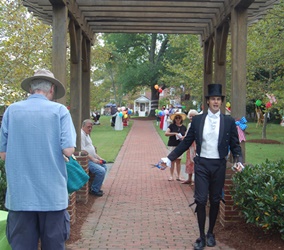
Jeremy Gershman, portraying Mr. C.H. Simpson, the Master of Ceremonies of London Vauxhall Gardens, opened the event and led guests through.
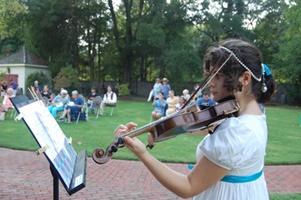
Micah Goettl accompanied the Colonial Dance Company, who greeted visitors as they entered the grounds.
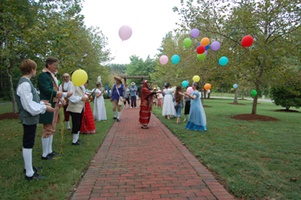

Throughout the day, everyone enjoyed the culinary creations of Lurlene Wagner.

Reenactors discussed the day with attendees like Mr. Welford Williams and his daughters.
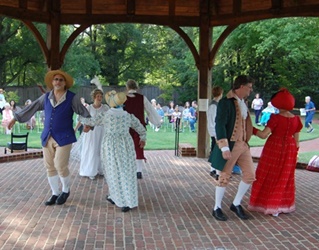
And inside the gazebo, the Colonial Dance Company performed. All told, the affair earned $1200 for Meadow Farm.
>Back to Top<
George Barksdale Recalls the Ceremony: Honoring the Unknown
On Armstice Day 1921, President Warren G. Harding presided over the dedication of the Tomb of the Unknown Soldier in Arlington Cemetery.
Three weeks before the dedication, the remains of four unidentified Americans had been exhumed from French graveyards; and in a selection ceremony, Sgt. Edward F. Younger selected one at random. The other three caskets were returned to their resting places in France, and the unknown soldier was brought back from France aboard the USS Olympia, accompanied by an honor guard of eight French ships.
So let us take a few minutes and revisit the original dedication through the recollections of Henrico resident George E. Barksdale, First Lieutenant in the Medical Reserve Corps in World War I. He attended the ceremony and recorded his observations in his diary, which are here reprinted:
An Account of the Internment of the Unknown Soldier at Arlington, November 11, 1921

I went to Washington especially to be present, and when cortege passed along the Avenue from the Capitol where the remains had been, after selection by a sergeant from five others, I stood along the street as te [sic] President, Generals Pershing and others with Admiral Beatty went afoot, while the car bearing the remains, with pall bearers selected from Medal of Honor men walked along side. Many Medal of Honor men accompanied the body as a guard of honor and I noted the carriage of Mr. Wilson with is [sic] wife in the parade. He did look so feeble and worn, and it is quite evident he has not long to live.

The President, pictured left, did not continue to Arlington but stopped at the White House, but I was curious to see it all so, I walked all the way and reached the auditorium out of doors where the funeral orations were to be spoken. Never, have I ever seen a more beautiful service. The band played those glorious old hymns: "Oh, God our Help in Ages Past", and as a processional the glorious "the Son of God goes forth to War" and lastly Rosa Ponselle, the New Haven opera singer singing "Lead Kindly Light." I shall never forget that service.
The tradition of interring an unknown soldier continued after World War II, the Korean War and the Vietnam War; but advances in DNA analysis have seemingly brought the practice to an end. In fact, the unknown soldier from Vietnam was identified in 1998 as Air Force Lieutenant Michael Blassie, and his remains were returned to St. Louis and buried with military honors.
Joey Boehling
Source: Barksdale family papers, 1917-1921, Library of Virginia
Cortege for the Unknown Soldier. The procession accompanying the remains proceeds through Washington on its way to Arlington National Cemetery.
In ill health. Former President Woodrow Wilson acknowledges the crowd viewing the procession, but his health did not allow him to continue on to the cemetery.
>Back to Top<
Moses Jacob Ezekiel
First Jewish VMI Cadet
Home always seems to call us. And for world-renowned sculptor Moses Jacob Ezekiel (October 28, 1844-March 27, 1917), a forty-year absence and a 4500-mile distance could not erase the tug of memory back to his home - his home in Henrico County. Writing his will in Rome in 1910, he recalled his origins: "I, Moses J. Ezekiel - the son of Jacob Ezekiel and his wife Catherine de Castro - of the town of Richmond in the county of Henrico, and state of Virginia-born October 28th 1844 - and being of sound and disposing mind and memory, do make, publish and declare, this my last will and testament." He had lived abroad since the age of 29, yet still Henrico County figured in his memory.
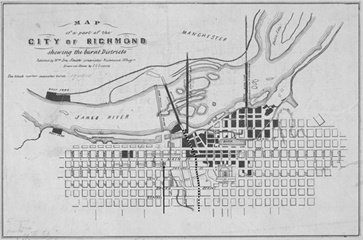
The Henrico County he lived in, however, is not the Henrico County of today. One of 14 children, he lived, it seems, on "Old Market Street," on the west side of 17th Sreet between Main and Franklin in what is today the City of Richmond. This was part of what the 1860 census notes as Ward 1. It was also called Jefferson Ward, one of three in the city, the other two being Madison and Monroe Ward. According to the Ordinances of the City of Richmond (1867): "Jefferson Ward shall include all that part of the city lying east of a line beginning at Mayo's bridge, running along the middle of 14th Street, as at present laid out, to Broad Street; thence across Broad street to College street to Marshall street; thence along the middle of Marshall street to 14th street to Shockoe creek; thence along said Shockoe creek; and thence along said branch to the corporation line."
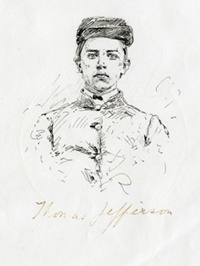
It was a poor area, and Moses was able to escape it in 1862 by enrolling at the Virginia Military Institute, where he was the first Jewish cadet admitted to the institute. He and other cadets participated in the Battle of New Market (May 14, 1864), also referred as the Field of Lost Shoes because the deep mud through which the soldiers slogged pulled off their shoes. As a result of that encounter, Ezekiel lost his roommate and best friend, Thomas Gardner Jefferson, pictured left. He recalled the aftermath of the battle in a letter he wrote from Rome on July 23, 1904. He recalled "after the Battle of New Market was over and we who survived answered the roll call on the field, I was in search of the wounded and found my room mate and comrade Thomas Jefferson lying on the floor of a hut quite exhausted and wounded in the breast. It was night and I was without shoes, as I had been all day and I went to the town of New Market and got a wagon and carried him to the house of Mrs. Clinedinst who gave me a bed for him on the ground floor. She had two daughters Anne and Lydie. It was Sunday night late when I got him into bed and from that time up to Tuesday night at about 11 o'clock I never left him a moment nor ever closed my eyes . . . I had Jefferson in my arms, and he died."

Moses Ezekiel, pictured right, also served in the defense of Richmond in 1865. After the war, he graduated from VMI in 1866 and studied anatomy at the Medical College of Virginia, nurturing his interest in sculpture. He came to the attention of Robert E. Lee, then president at the adjoining Washington College (later Washington and Lee). Lee encouraged him to pursue his art, and he did. He went to Cincinnati to study at the Art School of J. Insco Willias and in the studio of T.D. Jones. From there in 1867, he sailed for Europe, enrolling at the Royal Academy of Art in Berlin. There he began to make his mark on the art world at the age of 29, when with a bas relief entitled Israel, he became the first American to win the Michel-Beer Prix de Rome. The prize was named for Michael Beer, a German playwright and poet who had bequethed a large fortune, which was turned into a foundation administered by the Berlin Academy of Arts. It funded yearly awards given to two young artists, who had to be Jewish. It was to finance a one-year study period in Italy, of which at least six months had to be spent in Rome.
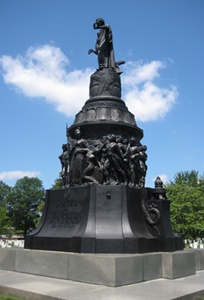
So to Rome Ezekiel went, and he spent the remainder of his life there, producing nearly two hundred monuments in bronze and marble. They include Homer and the Jefferson Monument at the University of Virginia, Virginia Mourning her Dead at his alma mater, a statue of Edgar Allan Poe in Baltimore and even a statue of Thoms Jefferson at the Virginia Museum of Fine Arts. Perhaps, his most important work is the 32 foot tall Confederate Soldiers memorial at Arlington National Cemetery, pictured left.
Ezekiel died in Italy on March 27, 1917, but because of World War I, his body was not returned to the United States. However, in 1921, he came back home to Virginia, when his body was put on a ship, brought back to America and buried in Section 16 of Arlington National Cemetery at the foot of his Confederate memorial.
Joey Boehling
Sources
Jewish Virtual Library. http://www.jewishvirtuallibrary.org/jsource/biography/mezekiel.html
Moses Jacob Ezekiel Papers. Manuscript # 0010, Virginia Military Institute Archives.
Smith, Peter Adams. The Life and Times of Moses Jacob Ezekiel, Farleigh Dickinson University; Lanham, MD, 2014.
>Back to Top<
Now You Know: With a Concave Mirror, a Postcard, and a Lot of Imagination in the User, the Showmescope Mimicked 3D
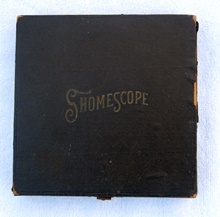
Today, we might take our smart phone, pop it into a virtual reality headset, put it on and enter an electronically created three-dimensional world. Of course, one hundred years ago, that was impossible. But perhaps one attempt to achieve that effect was more elegant - the Showmescope, pictured left in closed position. It was simple hinged pair of boards with a concave mirror positioned in the top to reflect and slightly distort a postcard or photograph inserted into a groove in the base.
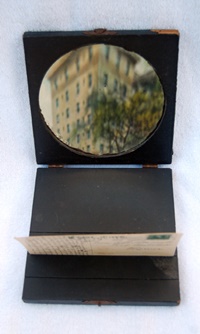
The effect, of course, was not really three-dimensional, but the slight bending in the reflected image provided an illusion of depth, and the slight enlargement made the viewing experience a bit more dramatic. That bending and enlarging can be seen in the photograph right that shows a Showmescope holding a postcard from 1917 featuring the Hotel Richmond, which today is a state office building across from Capitol Square.
The device came on the market around 1914 and was very affordable. An advertisement from a 1917 Popular Mechanics pictured below indicate that the Showmescope sold for $.93 - a good deal less than today's virtual reality devices. And it was also cheaper than the popular stereoscope of that time, a viewer that produced its very realistic three-dimensional effect through the use of two slightly different side-by-side photographic images.
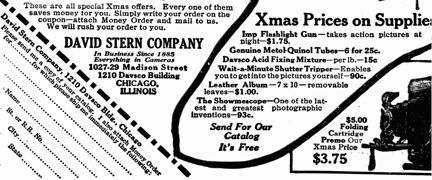
While the effect seems rather primitive by today's standards, on a greater level, the device illustrates the basic American drive to make life easier and better for all. Can't afford a stereoscope - get a Showmescope. And, of course, both devices eventually gave way to more sophisticated designs. As Jake Silverstein wrote in the November 23, 2016 edition of The New York Times Magazine, "No design is ever permanent but merely a way station between what a thing used to be and what it might yet become."
But as our designs have become more sophisticated, there is always a sense that something has also been lost. We smile at the relative ineffectiveness of the Showmescope but overlook the significance of an item as simple as the picture postcard.
In the march of progress, that document has been supplanted by the same technology that made the Showmescope and stereoscope obsolete. Now, it's Instagram or Snapchat or some other electronic messaging. It is communication that is not physical and at least semi-permanent, but supremely ephermeral - gone once it is read, or more likely, glanced at. No stamp applied, no more thought over and handwritten, no effort to find a mailbox and send it. We won't find those messages in boxes in an attic or in a scrapbook, saved because they meant something to someone. We won't find them propped on the piano or stuck on the refrigerator. Things are just a little more distant and impersonal today.
We can't go back to older times, nor should we. But we need to remember the things of those older times that had some meaning, however small - like postcards. And so we ask you to share with us any old postcards you might have showing scenes and sights in Henrico County from bygone days to be included in future newsletters. Recognizing the irony, we ask you to email copies of them to the same email address where you send your "What Do You Know?" answers. Or let us know, and we'll figure out how to get a copy. We look forward to hearing from you.
>Back to Top<
What Do You Know?
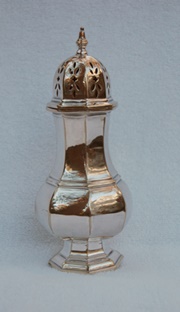
This silverplated item is 8 inches tall. There are perforations at the top.
Do you know what it is?
Email your answers to:
jboehling@verizon.net
>Back to Top<
News 2016: Fourth Quarter
First Quarter | Second Quarter | Third Quarter
Home | Henrico | Maps | Genealogy | Preservation | Membership | Shopping | HCHS
|











